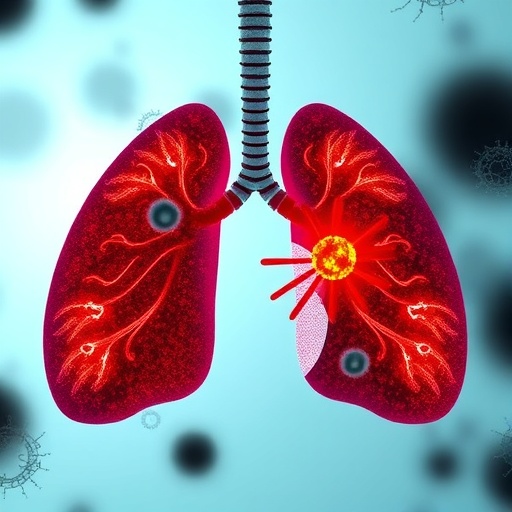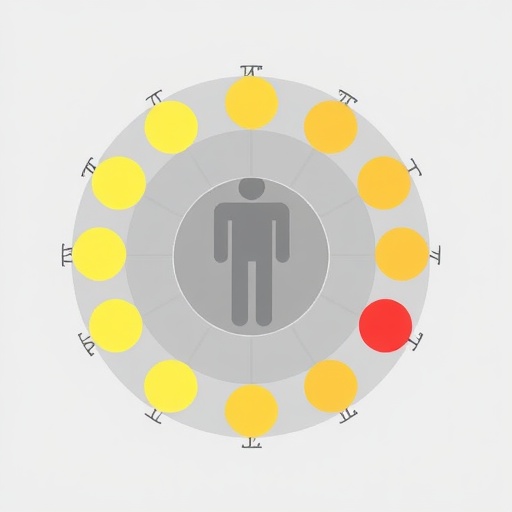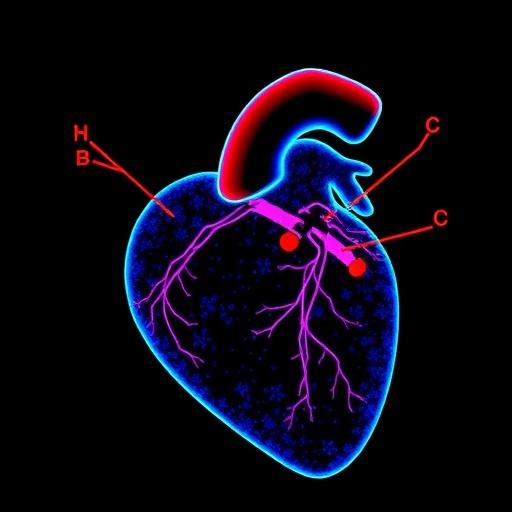
In a groundbreaking advance that sheds new light on the complex immunological mechanisms driving chronic airway diseases, a team of researchers has uncovered a previously unappreciated role for a subset of innate immune cells marked by Toll-like receptor 4 (TLR4) expression. This discovery not only challenges the traditional paradigms of type 2 immunity but also opens promising avenues for targeted therapeutic interventions aimed at respiratory conditions such as asthma, chronic rhinosinusitis, and allergic airway inflammation. The study, published in Nature Communications by Li, Wang, Duan, and colleagues in 2025, provides compelling evidence that TLR4-positive group 2 innate lymphoid cells (ILC2s) contribute crucially to the persistence of type 2 immune responses in the airways, offering new mechanistic insights into why these conditions often become refractory to current treatments.
Type 2 immunity, characterized by the production of cytokines such as IL-4, IL-5, and IL-13, is traditionally driven by adaptive immune cells, prominently T helper 2 (Th2) cells. However, the emergence of ILC2s as key players in the early and innate phases of allergic airway diseases has revolutionized our understanding of how the immune system orchestrates such responses. These innate lymphoid cells operate at mucosal surfaces and can rapidly produce type 2 cytokines in response to epithelial-derived alarmins. Until now, the regulatory networks that sustain their activity over the long term and their potential crosstalk with pathogen recognition receptors were only partially understood.
Central to the new findings reported by Li et al. is the identification of a distinct subset of ILC2s that express TLR4, a pattern recognition receptor best known for detecting bacterial lipopolysaccharides and initiating innate immune responses against gram-negative bacteria. The intriguing expression of TLR4 on ILC2s suggests a direct interface between microbial sensing and type 2 immunity, a connection that was largely speculative before this investigation. Using a combination of murine airway disease models and human tissue samples, the researchers demonstrated that TLR4+ ILC2s not only proliferate in inflamed airways but also produce robust levels of canonical type 2 cytokines, thereby amplifying and sustaining the allergic inflammatory milieu.
.adsslot_t6kM8vHdQ1{width:728px !important;height:90px !important;}
@media(max-width:1199px){ .adsslot_t6kM8vHdQ1{width:468px !important;height:60px !important;}
}
@media(max-width:767px){ .adsslot_t6kM8vHdQ1{width:320px !important;height:50px !important;}
}
ADVERTISEMENT
The persistence of airway inflammation poses one of the greatest challenges in managing chronic respiratory diseases. Many patients experience recurrent exacerbations and poor responses to standard corticosteroid therapies. Li and team’s discovery implicates TLR4 signaling on ILC2s as a potential driver of these treatment-resistant phenotypes. When engaged, TLR4 appears to enhance the survival and cytokine secretion of ILC2s, effectively maintaining a pro-inflammatory loop within the airway mucosa. This finding suggests that microbial components or endogenous TLR4 ligands released during tissue damage could chronically stimulate ILC2s, perpetuating the type 2 environment and hindering resolution.
The mechanistic dissection provided by the study unveiled that TLR4 engagement not only triggers traditional downstream signaling pathways such as NF-κB and MAP kinases but also modulates metabolic programs within ILC2s. These alterations support heightened cellular activation and cytokine production over prolonged periods. Importantly, the researchers discovered that blocking TLR4 signaling pharmacologically or genetically dampened ILC2 expansion and type 2 cytokine output in experimental models, pointing to a viable immunomodulatory strategy. This approach could complement existing biologic therapies that target IL-5 or IL-13 but fail to address upstream innate activation pathways.
One of the most striking aspects of this research is the personalized translational potential it carries. By analyzing airway biopsies from patients with severe asthma and chronic rhinosinusitis, the investigators found elevated frequencies of TLR4+ ILC2s, correlating with disease severity and corticosteroid resistance. This correlation suggests that measuring TLR4 expression on ILC2s could serve as a biomarker for patient stratification and help tailor precision medicine approaches. Furthermore, it signals the need for clinical trials to evaluate TLR4 antagonists or inhibitors as adjunct treatments for refractory airway inflammation.
Beyond its clinical implications, the discovery fundamentally enriches the conceptual framework of innate immunity in the respiratory system. It posits a dual sensory function for ILC2s: not only do they respond to alarmins released by epithelial cells, but they also directly detect microbial and endogenous danger signals via TLR4. This duality ensures a robust and sustained type 2 immune response that might have evolved to provide rapid defense against parasitic infections but becomes maladaptive in allergic disease contexts where persistent stimulation leads to chronic pathological inflammation.
Moreover, this research highlights the intricate interplay between environmental factors and host immunity. Given that airways are constantly exposed to diverse microbial communities and pollutants, the ability of ILC2s to sense TLR4 ligands situates them at a critical nexus mediating environmental influences on immune responses. It raises provocative questions about how dysbiosis, repeated infections, or exposure to environmental endotoxins could modulate disease trajectories via TLR4+ ILC2s. Exploring these dimensions could unravel novel preventive strategies for airway inflammatory disorders.
Technically, the study implemented cutting-edge single-cell RNA sequencing and flow cytometric profiling to define the TLR4+ ILC2 subset with unprecedented resolution. Functional assays validated their unique cytokine secretion profiles, and sophisticated genetic mouse models enabled precise manipulation of TLR4 expression on ILC2s. These comprehensive experimental frameworks ensured that findings were robust, reproducible, and relevant across species. The integration of human tissue analyses further enhanced the translational impact by bridging animal models with human pathophysiology.
The implications of these findings extend beyond airway diseases. Considering that ILC2s are present in multiple mucosal tissues, the concept of TLR4-mediated modulation may be pertinent to other chronic inflammatory or allergic conditions such as eosinophilic esophagitis, atopic dermatitis, or even some forms of chronic rhinitis. Understanding how TLR4+ ILC2s function within different tissue microenvironments could reveal universal principles governing innate type 2 immunity and identify common therapeutic targets.
One challenge moving forward will be to unravel the precise endogenous and exogenous ligands that chronically activate TLR4 on ILC2s within the airways. While bacterial products are clear candidates, emerging data suggest that damage-associated molecular patterns (DAMPs) generated during tissue injury or oxidative stress might also serve as ligands. Pinpointing these stimuli will be critical to designing effective and safe therapies, as indiscriminate TLR4 blockade could compromise essential host defense mechanisms.
Future research, inspired by this seminal work, will likely investigate how TLR4 signaling interfaces with other innate receptors and cellular networks within the airway niche. For instance, crosstalk between TLR4+ ILC2s and airway epithelial cells, dendritic cells, or macrophages could orchestrate complex inflammatory cascades. Dissecting these interactions through spatial transcriptomics and advanced imaging techniques holds promise for uncovering multi-dimensional regulatory circuits underpinning chronic airway inflammation.
Furthermore, understanding the developmental origins and differentiation pathways of TLR4+ ILC2s may reveal whether this subset arises from distinct progenitors or represents an activated state within the broader ILC2 population. Insights into the epigenetic and transcriptional programs governing TLR4 expression on ILC2s could provide novel entry points for pharmacological modulation, potentially offering more specificity than targeting downstream cytokines alone.
Clinically, the prospect of targeting TLR4+ ILC2s revitalizes the conversation around immune modulation in chronic airway diseases, particularly for patients who suffer from frequent exacerbations despite adherence to guideline-directed therapies. The integration of TLR4 blockade strategies with biologics, inhaled corticosteroids, or novel small molecules could transform the therapeutic landscape by addressing both innate triggers and adaptive effectors of type 2 inflammation. This multipronged approach aligns with the current push toward precision medicine in respiratory care.
In conclusion, the identification of TLR4-positive group 2 innate lymphoid cells as key contributors to persistent type 2 immunity offers a paradigm-shifting perspective on the immunological underpinnings of chronic airway diseases. The work of Li and colleagues represents a significant milestone that bridges innate sensing mechanisms with sustained pathological inflammation, challenging existing dogmas and charting new pathways toward improved diagnosis, prognosis, and treatment. As the field embraces these insights, patients suffering from asthma, chronic rhinosinusitis, and related disorders may soon benefit from innovative therapies targeting the very cellular culprits that sustain their disease.
Subject of Research: The role of TLR4-positive group 2 innate lymphoid cells (ILC2s) in sustaining persistent type 2 immune responses in chronic airway diseases.
Article Title: TLR4+ group 2 innate lymphoid cells contribute to persistent type 2 immunity in airway diseases.
Article References:
Li, Y., Wang, Z., Duan, S. et al. TLR4+group 2 innate lymphoid cells contribute to persistent type 2 immunity in airway diseases.
Nat Commun 16, 7108 (2025). https://doi.org/10.1038/s41467-025-62532-0
Image Credits: AI Generated
Tags: breakthroughs in airway disease researchchallenges in treating airway diseaseschronic airway inflammation mechanismscytokine production in allergic responsesimmunological mechanisms in chronic rhinosinusitisinnate lymphoid cells and asthmaNature Communications immunology studypersistent type 2 immunity in airwaysrole of ILC2s in respiratory diseasestargeted therapies for asthmaTLR4 expression in innate immune cellstype 2 immune response dynamics





